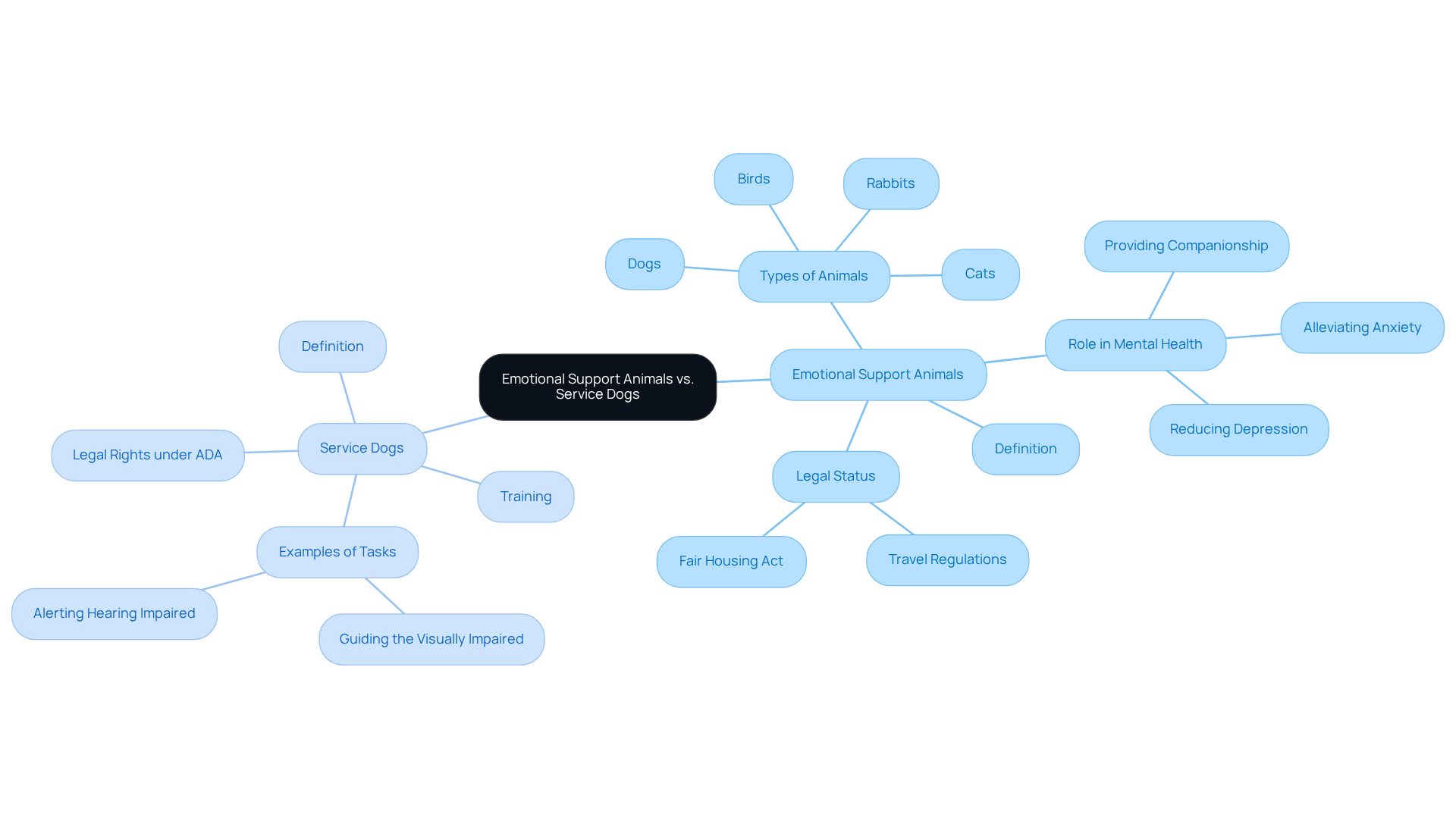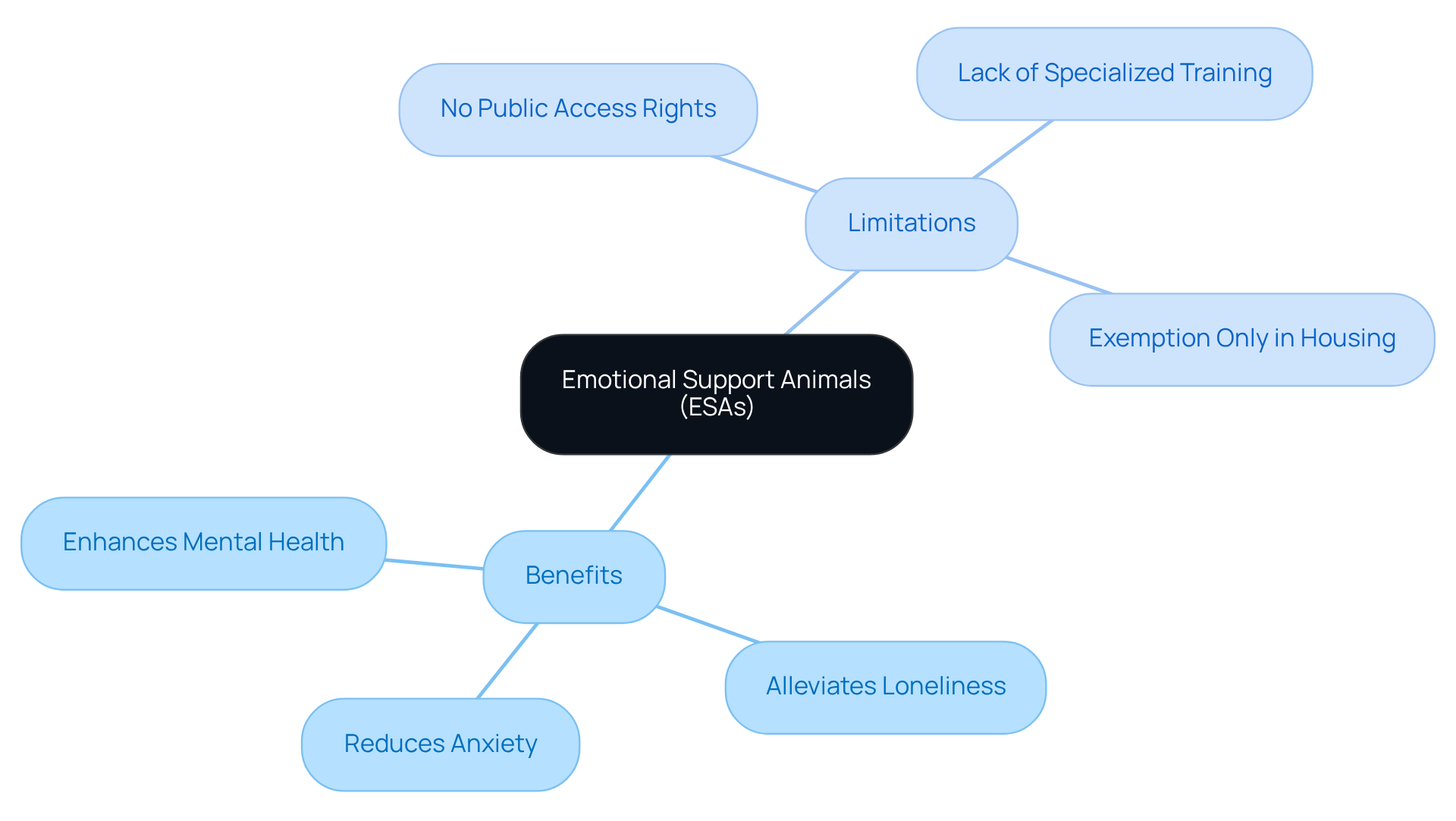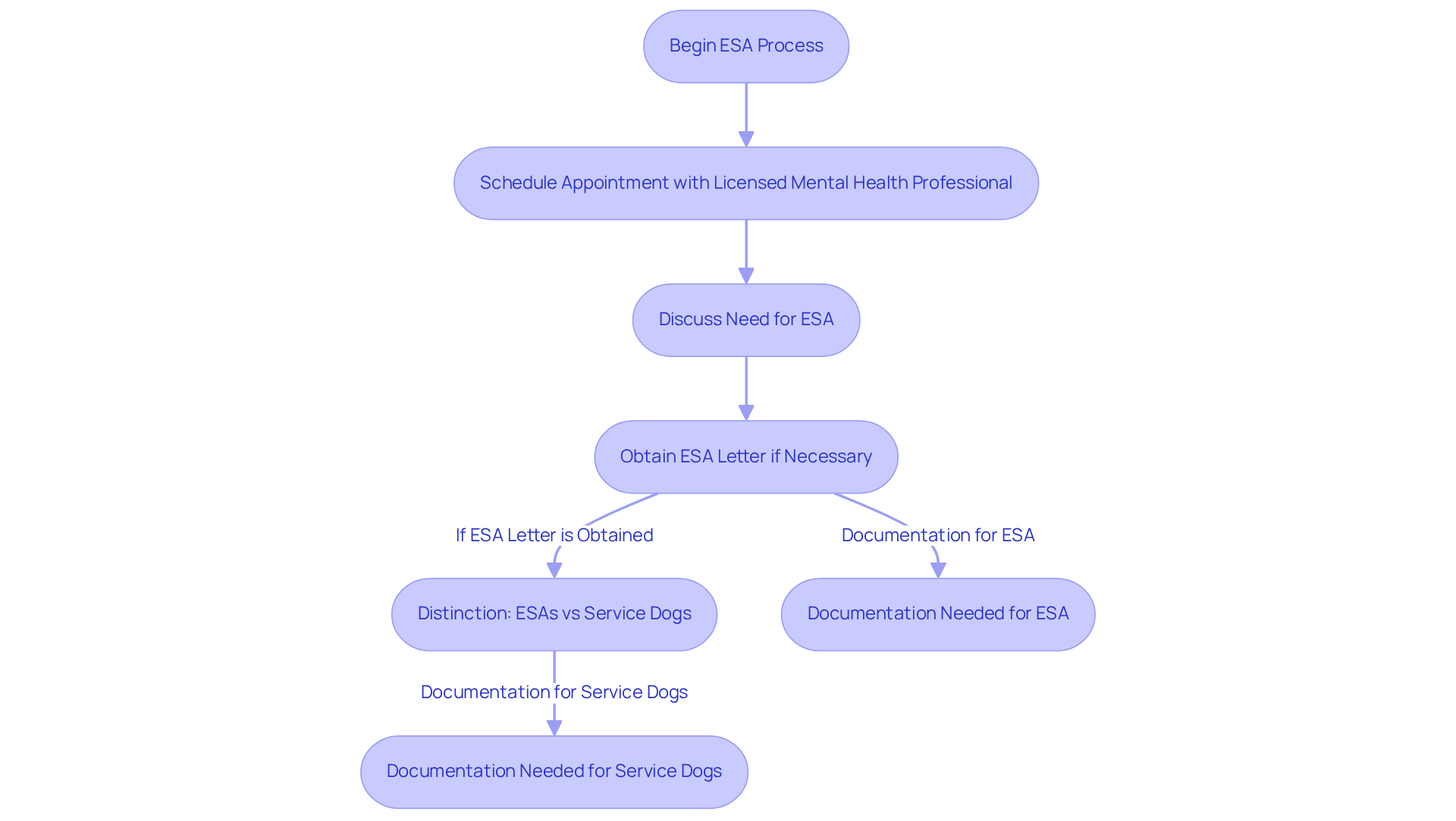

Emotional Support vs Service Dog: Key Differences Explained
by Lena Park
Last updated: August 24, 2025
Verified and Approved by:
Angela Morris,
MSW, LCSW
Fact Checked

Overview
Emotional Support Animals (ESAs) play a crucial role in providing emotional comfort to individuals grappling with mental health challenges. Unlike Service Dogs, which are trained to perform specific tasks for individuals with disabilities and enjoy broader public access rights under the ADA, ESAs are primarily there to offer solace and support.
It’s essential to recognize that while ESAs are vital for mental well-being, they face significant limitations in public access and lack the same legal protections as Service Dogs. Understanding these distinctions is important for those seeking support, as it can guide them in making informed decisions about their emotional health and the assistance available to them.
Introduction
Understanding the distinction between emotional support animals and service dogs is essential for anyone navigating the complexities of mental health support and legal rights. Many individuals face emotional challenges that can feel overwhelming, and recognizing the role of these animals can provide clarity and comfort.
While both types of animals offer significant benefits, their roles, training, and legal protections differ dramatically. This article delves into these key differences, exploring the unique advantages and limitations of each. It poses an important question: How can individuals best advocate for their rights and the support they need in a world that often blurs these lines?
By shedding light on this topic, we can foster understanding and compassion for those seeking the support they deserve.
Define Emotional Support Animals and Service Dogs
Emotional Support Animals provide invaluable comfort and emotional assistance to those grappling with mental health challenges, including anxiety, depression, and PTSD. Unlike assistance dogs, which are specifically trained to perform certain tasks, the distinction of emotional support vs service dog lies in the fact that emotional support animals primarily alleviate emotional distress through their companionship. The Americans with Disabilities Act (ADA) defines Service Animals strictly as dogs (and, in some cases, miniature horses) trained to assist individuals with disabilities, such as guiding the visually impaired or alerting those with hearing impairments. In contrast, emotional support animals can include a broader range of domesticated creatures, such as cats, rabbits, and birds.
The presence of emotional support animals is significant, with approximately 18% of pet owners in the U.S. having one. This number continues to rise as awareness of their mental health benefits grows. Experts highlight the essential role that emotional support animals play in mental health care, serving as vital resources for individuals facing emotional challenges. While assistance animals have public access rights under the ADA, the distinction of emotional support vs service dog emphasizes that emotional support animals do not share the same privileges, underscoring the importance of recognizing their distinct roles in fostering mental well-being.
Wellness Wag offers a compassionate and accessible process for obtaining ESA letters, featuring interest-free payment plans and a Money-Back Guarantee, ensuring that clients can access the support they need. Client testimonials illustrate the seamless approval process, reinforcing the profound impact of ESAs in enhancing emotional health. Have you ever considered how an emotional support animal could transform your life? Their presence might just be the comforting support you need on your journey to emotional well-being.

Compare Legal Rights and Protections
Assistance animals receive vital legal protections under the Americans with Disabilities Act (ADA), allowing them access to public spaces such as restaurants, shops, and public transport. This means that businesses are required to welcome assistance animals as long as they are performing their essential roles. However, Emotional Support Animals (ESAs) are primarily safeguarded under the Fair Housing Act (FHA), which mandates that housing providers allow these animals, even in places with strict no-pet policies. Yet, it’s important to note the differences in emotional support vs service dog access rights, as emotional support animals do not enjoy the same public access rights as Service Dogs. For example, hotels and restaurants are not obligated to accommodate them, while Service Dogs must be allowed. This legal distinction can create significant hurdles for ESA owners who seek access to public spaces.
Current statistics reveal that disability discrimination is still a pressing issue, with 52.61% of fair housing complaints in 2023 falling into this category. Recent discussions in the news highlight the urgent need for clearer regulations regarding ESA access in public settings, as many individuals remain unaware of their rights under the FHA. Understanding the differences in emotional support vs service dog is crucial for ESA owners as they navigate their legal protections and access rights.
It’s essential to recognize the emotional challenges faced by those who rely on ESAs for support. The journey can often feel overwhelming, but there is hope and assistance available. ESA letters can serve as a valuable tool, providing the necessary documentation to help ease some of the burdens. By understanding your rights and the protections afforded to you, you can advocate for yourself and your emotional support animal with confidence.

Evaluate Practical Benefits and Limitations
Emotional Support Animals (ESAs) play a vital role in providing emotional assistance, significantly enhancing mental health and overall well-being. They help alleviate feelings of loneliness and anxiety, making them particularly invaluable for individuals facing mental health challenges.
Have you ever felt overwhelmed by anxiety or the weight of isolation? Research shows that emotional support animals can effectively reduce symptoms of anxiety and depression, offering companionship that fosters emotional stability.
Yet, it’s important to recognize the differences in emotional support vs service dog, as emotional support animals do not have the specialized training or public access rights that service dogs possess. For instance, Service Dogs are trained to perform specific tasks, such as alerting individuals with diabetes to low blood sugar levels or assisting those with mobility impairments. This distinction highlights a crucial limitation of emotional support vs service dog alternatives: their inability to provide direct assistance in practical situations.
Moreover, without formal training requirements, emotional support animals may not be permitted in certain public spaces, which can hinder their effectiveness as sources of support. Real-world experiences illustrate how emotional support animals contribute to improved well-being; many individuals report enhanced emotional regulation and reduced feelings of isolation when accompanied by their support animals.
A client, James B., shared, “Thanks to Wellness Wag, I received approval for my ESA quickly and without any difficulties. Their staff is friendly and caring.”
Furthermore, under the Fair Housing Act, individuals with a prescription for an ESA are exempt from pet bans in housing situations, highlighting the differences in emotional support vs service dog, although they do not enjoy the same public access rights as assistance animals. This legal safeguard highlights the importance of ESAs in providing emotional support, even as they do not replace the practical aid that assistance animals offer to individuals with disabilities.

Outline Certification and Documentation Processes
For many individuals grappling with mental health challenges, the journey can feel overwhelming. Securing an Emotional Support Animal (ESA) can be a vital step toward emotional relief and stability. To obtain an ESA, individuals need to acquire a letter from a licensed mental health professional. This letter confirms the necessity of emotional support due to a mental health condition and serves as essential documentation for housing and travel accommodations, advocating for the rights of ESA owners under the Fair Housing Act.
It’s important to understand the distinction between emotional support vs service dog and other assistance animals. Unlike ESAs, assistance animals are not required to undergo formal certification or registration under the Americans with Disabilities Act (ADA). However, they must be specifically trained to perform tasks that assist their owners with disabilities. While some organizations offer certification for assistance animals, it is not legally mandated. Owners may choose to have their Service Dogs wear vests or identification tags to indicate their status, but this practice is also not a legal requirement.
In a significant change, Air Canada no longer recognizes emotional support animals for travel. However, when discussing emotional support vs service dog rights, psychiatric service dogs can still travel with the right documentation, including a U.S. DOT form and a recommended PSD letter for a smooth check-in process.
If you are considering an ESA, you may wonder how to begin this journey. Typically, individuals follow these steps:
- Schedule an appointment with a licensed mental health professional
- Discuss the need for an ESA
- Obtain the ESA letter if deemed necessary
This process can provide a sense of hope and support.
Real-world experiences illustrate that having proper ESA documentation can significantly ease housing and travel challenges, ensuring that individuals receive the support they need. Remember, you are not alone in this journey, and the support of an ESA can make a meaningful difference in your life.

Conclusion
Understanding the distinctions between Emotional Support Animals (ESAs) and Service Dogs is crucial for individuals seeking the right support for their unique needs. Many people face emotional challenges, and it’s important to recognize how these animals can play a role in enhancing well-being. While both types of animals serve important functions, their roles, legal protections, and practical implications differ significantly.
- ESAs primarily provide emotional comfort and companionship, addressing the need for connection and support.
- In contrast, Service Dogs are trained to perform specific tasks that assist individuals with disabilities, granting them access to a broader range of public spaces under the Americans with Disabilities Act.
The article delves into various aspects, including the definitions of both types of animals, their legal rights, and the benefits and limitations they offer. It highlights the emotional relief that ESAs provide, emphasizing how they can be a source of comfort during difficult times. Additionally, it underscores the vital legal protections for Service Dogs and the importance of understanding one’s rights under the Fair Housing Act.
By sharing these insights, we aim to clarify the landscape of emotional support and service animals, ensuring that individuals can make informed decisions about their mental health support.
Ultimately, recognizing the unique roles of Emotional Support Animals and Service Dogs can empower individuals to seek the appropriate assistance they need. Whether you are considering an ESA for emotional comfort or a Service Dog for practical assistance, understanding these distinctions not only enhances personal well-being but also fosters a more inclusive environment for all individuals with disabilities. This knowledge serves as a vital tool in advocating for oneself, ensuring that the support system in place is both effective and legally protected.
Remember, you are not alone in this journey, and the right support is available to help you navigate your path to well-being.
Frequently Asked Questions
What are Emotional Support Animals (ESAs)?
Emotional Support Animals provide comfort and emotional assistance to individuals dealing with mental health challenges, such as anxiety, depression, and PTSD. They primarily alleviate emotional distress through companionship.
How do Emotional Support Animals differ from Service Dogs?
The main difference is that Service Dogs are specifically trained to perform tasks to assist individuals with disabilities, while Emotional Support Animals are not trained for specific tasks and focus on providing emotional comfort.
What types of animals can be considered Emotional Support Animals?
Emotional Support Animals can include a wide range of domesticated creatures, such as dogs, cats, rabbits, and birds.
What is the legal definition of Service Animals under the Americans with Disabilities Act (ADA)?
The ADA defines Service Animals strictly as dogs (and, in some cases, miniature horses) that are trained to assist individuals with disabilities, such as guiding the visually impaired or alerting those with hearing impairments.
Do Emotional Support Animals have the same public access rights as Service Dogs?
No, Emotional Support Animals do not share the same public access rights under the ADA as Service Dogs, highlighting the importance of recognizing their distinct roles in mental well-being.
How prevalent are Emotional Support Animals among pet owners in the U.S.?
Approximately 18% of pet owners in the U.S. have an Emotional Support Animal, and this number continues to rise as awareness of their mental health benefits grows.
What services does Wellness Wag offer for obtaining ESA letters?
Wellness Wag offers a compassionate and accessible process for obtaining ESA letters, including interest-free payment plans and a Money-Back Guarantee to ensure clients can access the support they need.
What do client testimonials say about the process of obtaining ESA letters from Wellness Wag?
Client testimonials illustrate a seamless approval process and reinforce the profound impact of Emotional Support Animals in enhancing emotional health.
Certify Your Emotional Support Animal Today

Why You Can Rely on Us?
At Wellness Wag, we believe your pet deserves care rooted in both science and compassion. Each article is carefully researched, written in clear language for pet owners, and then reviewed by qualified professionals to ensure the information is evidence-based, current, and practical for real-life care. Our goal is to help you feel confident in making informed decisions about your pet’s health and well-being.
Reviewed by
Angela Morris, MSW, LCSW
Angela is a licensed clinical social worker with 20 years of experience in patient advocacy and community mental health. She has assisted numerous clients with ESA evaluations and brings a deep understanding of disability accommodations, ensuring that all information is accurate, supportive, and practical.

Written by :
Lena Park
Last Updated :
August 24, 2025












